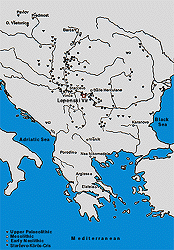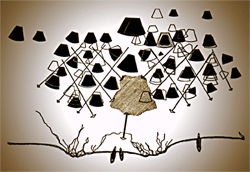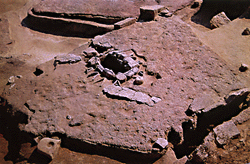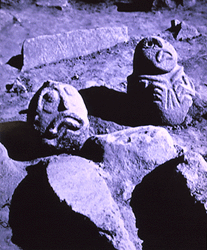 |

The site Lepenski Vir is located at the so called "Iron Gates" of the Danube, approximately 150 kilometres east of Belgrade. The excavations conducted by D. Srejovic (1965-69) on a sandy bank terrace, measuring 170X50 m., revealed a settlement which was inhabited between 6600 and 4500 BC. The three main habitation phases of the settlement (Lepenski Vir I-III) date to the Mesolithic Period (Lepenski Vir I-II) and to the transitional phase from the Mesolithic to the Neolithic Period (Lepenski Vir III). The first settlement period (Lepenski Vir Ia) was characterised by huts made of wood or reeds. The economy of the settlement was almost exclusively based on fishing. Many generations inhabited the area before the settlement was abandoned suddenly for no apparent reason. The civilization that developed there during the early Mesolithic Period is known as the "Proto-Lepenski Vir civilization" (6600-6000 BC). |

After this sudden abandonment, the site was inhabited by a new population until the end of the Mesolithic Period. The architectural phases Lepenski Vir Ib-e and Lepenski Vir II covered the period from 6000-5500 BC and constitued the so-called "Lepenski Vir civilization". The settlement in these phases was characterised by trapezoid houses with stone-built foundations and a gable roof. Their size varied (6-30 sqm) but the proportions were identical. The length of the sides was exactly 3/4 of the long side of the trapezium. The strict adherence to the proportions and the layout of the buildings indicate the observance of a triangular system, a unique event in the history of architecture. |

The entrance of the buildings was, as a rule, on the eastern long side. In the interior there was a hearth separated from the rest of the room by stones in a vertical position around it. At the centre of every hearth there was a stone with a crescent hollow, a kind of altar. The floors were paved with extremely hard lime mortar and painted either red or white. |

Inside the buildings, and in particular in the area around the hearth, stone sculptures made of coarse clast sandstone were found dating to the phase Lepenski Vir Ib and to five successive phases. Their size is 16-60 cm. and they represent human heads with protruding eyes and lips or complete figures with a fish's body. The types of sculptures and their position near the hearth suggest that they were figures of worship which probably symbolized river gods. Besides the sculptured figures, river stones with engraved and bas-relief geometric decorative themes were found. The coexistence of more than one sculpture combined with the burial of male adults or the deposition of skeletons around the hearth suggest that, at Lepenski Vir, the zone around the hearth was some kind of domestic altar. Subjects of worship were usually the hearth, the sun, the river gods and dead ancestors. The finds of Lepenski Vir revealed the earliest large sculptures in Europe and the practise of organized worship carried out separately in each domestic unit. The oldest specimens of great plastic related to organized worship and the presence of altars were unearthed in a settlement in the Near East (Nevali Cori) and date back to the 10th millennium BC. The archaeological remains of Lepenski Vir Ib-II are a unique example in the Balkans and Europe, for the Mesolithic Period, of a society of hunters, fishermen and food-gatherers who organized a settlement on a site geomorphologically impressive but not fertile. The settlement is characterized by its austere architectural style, and for namy hundent years operated under complicated principles of social and religious organization. The flourishing Mesolithic "Lepenski Vir civilization" was succeeded, during the early Mesolithic, by simple and less impressive constructions of the phase Lepenski Vir III. |
 |
 |
 |
 |
 |
 |